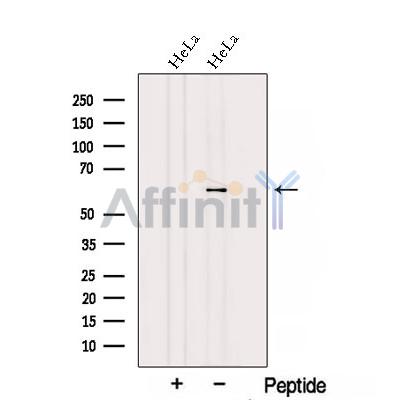TBCE Antibody - #DF12766
| 製品: | TBCE Antibody |
| カタログ: | DF12766 |
| タンパク質の説明: | Rabbit polyclonal antibody to TBCE |
| アプリケーション: | WB IF/ICC |
| 反応性: | Human, Mouse, Rat, Monkey |
| 予測: | Pig, Zebrafish, Bovine, Sheep, Rabbit, Dog, Xenopus |
| 分子量: | 59 kDa; 59kD(Calculated). |
| ユニプロット: | Q15813 |
| RRID: | AB_2845727 |
製品説明
*The optimal dilutions should be determined by the end user.
*Tips:
WB: For western blot detection of denatured protein samples. IHC: For immunohistochemical detection of paraffin sections (IHC-p) or frozen sections (IHC-f) of tissue samples. IF/ICC: For immunofluorescence detection of cell samples. ELISA(peptide): For ELISA detection of antigenic peptide.
引用形式: Affinity Biosciences Cat# DF12766, RRID:AB_2845727.
折りたたみ/展開
HRD; KCS; KCS1; Pac2; tbce; TBCE_HUMAN; Tubulin specific chaperone e; Tubulin-folding cofactor E; Tubulin-specific chaperone E;
免疫原
- Q15813 TBCE_HUMAN:
- Protein BLAST With
- NCBI/
- ExPASy/
- Uniprot
MSDTLTADVIGRRVEVNGEHATVRFAGVVPPVAGPWLGVEWDNPERGKHDGSHEGTVYFKCRHPTGGSFIRPNKVNFGTDFLTAIKNRYVLEDGPEEDRKEQIVTIGNKPVETIGFDSIMKQQSQLSKLQEVSLRNCAVSCAGEKGGVAEACPNIRKVDLSKNLLSSWDEVIHIADQLRHLEVLNVSENKLKFPSGSVLTGTLSVLKVLVLNQTGITWAEVLRCVAGCPGLEELYLESNNIFISERPTDVLQTVKLLDLSSNQLIDENQLYLIAHLPRLEQLILSDTGISSLHFPDAGIGCKTSMFPSLKYLVVNDNQISQWSFFNELEKLPSLRALSCLRNPLTKEDKEAETARLLIIASIGQLKTLNKCEILPEERRRAELDYRKAFGNEWKQAGGHKDPEKNRLSEEFLTAHPRYQFLCLKYGAPEDWELKTQQPLMLKNQLLTLKIKYPHQLDQKVLEKQLPGSMTIQKVKGLLSRLLKVPVSDLLLSYESPKKPGREIELENDLKSLQFYSVENGDCLLVRW
種類予測
Score>80(red) has high confidence and is suggested to be used for WB detection. *The prediction model is mainly based on the alignment of immunogen sequences, the results are for reference only, not as the basis of quality assurance.
High(score>80) Medium(80>score>50) Low(score<50) No confidence
PTMs - Q15813 基板として
| Site | PTM Type | Enzyme | Source |
|---|---|---|---|
| S2 | Acetylation | Uniprot | |
| S2 | Phosphorylation | Uniprot | |
| T4 | Phosphorylation | Uniprot | |
| T6 | Phosphorylation | Uniprot | |
| K48 | Ubiquitination | Uniprot | |
| K60 | Ubiquitination | Uniprot | |
| K86 | Ubiquitination | Uniprot | |
| K109 | Ubiquitination | Uniprot | |
| K121 | Ubiquitination | Uniprot | |
| S124 | Phosphorylation | Uniprot | |
| S127 | Phosphorylation | Uniprot | |
| K128 | Ubiquitination | Uniprot | |
| S133 | Phosphorylation | Uniprot | |
| K145 | Ubiquitination | Uniprot | |
| K192 | Ubiquitination | Uniprot | |
| S195 | Phosphorylation | Uniprot | |
| T200 | Phosphorylation | Uniprot | |
| S204 | Phosphorylation | Uniprot | |
| K346 | Ubiquitination | Uniprot | |
| K370 | Ubiquitination | Uniprot | |
| K387 | Ubiquitination | Uniprot | |
| K394 | Ubiquitination | Uniprot | |
| S408 | Phosphorylation | Uniprot | |
| K434 | Ubiquitination | Uniprot | |
| K442 | Ubiquitination | Uniprot | |
| K451 | Acetylation | Uniprot | |
| K451 | Ubiquitination | Uniprot | |
| K459 | Ubiquitination | Uniprot | |
| K463 | Acetylation | Uniprot | |
| K463 | Ubiquitination | Uniprot | |
| S479 | Phosphorylation | Uniprot | |
| S487 | Phosphorylation | Uniprot | |
| S495 | Phosphorylation | P24941 (CDK2) | Uniprot |
研究背景
Tubulin-folding protein; involved in the second step of the tubulin folding pathway and in the regulation of tubulin heterodimer dissociation. Required for correct organization of microtubule cytoskeleton and mitotic splindle, and maintenance of the neuronal microtubule network.
Cytoplasm. Cytoplasm>Cytoskeleton.
Supercomplex made of cofactors A to E. Cofactors A and D function by capturing and stabilizing tubulin in a quasi-native conformation. Cofactor E binds to the cofactor D-tubulin complex; interaction with cofactor C then causes the release of tubulin polypeptides that are committed to the native state. Cofactors B and E can form a heterodimer which binds to alpha-tubulin and enhances their ability to dissociate tubulin heterodimers (By similarity). Interacts with TBCD.
Belongs to the TBCE family.
Restrictive clause
Affinity Biosciences tests all products strictly. Citations are provided as a resource for additional applications that have not been validated by Affinity Biosciences. Please choose the appropriate format for each application and consult Materials and Methods sections for additional details about the use of any product in these publications.
For Research Use Only.
Not for use in diagnostic or therapeutic procedures. Not for resale. Not for distribution without written consent. Affinity Biosciences will not be held responsible for patent infringement or other violations that may occur with the use of our products. Affinity Biosciences, Affinity Biosciences Logo and all other trademarks are the property of Affinity Biosciences LTD.


